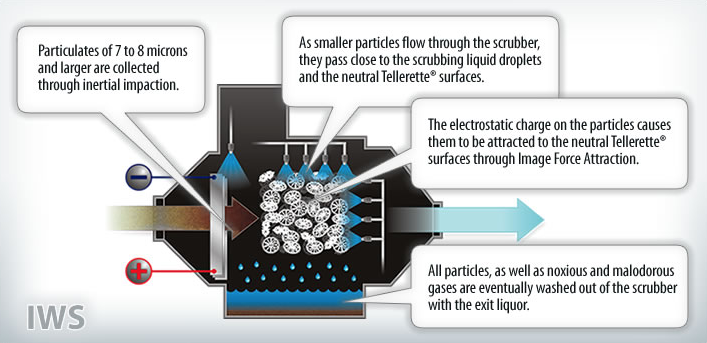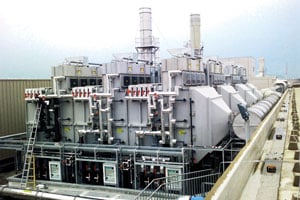 The Verantis® Ionizing Wet Scrubbers, or IWS®, are developed to simultaneously remove noxious gases and particulates from industrial process airstreams while eliminating opacity. With more than 100 installations worldwide, IWS systems have been at work for five decades, solving the most demanding environmental control challenges.
The Verantis® Ionizing Wet Scrubbers, or IWS®, are developed to simultaneously remove noxious gases and particulates from industrial process airstreams while eliminating opacity. With more than 100 installations worldwide, IWS systems have been at work for five decades, solving the most demanding environmental control challenges.
Verantis® produces a wide range of wet scrubbers suited to virtually every industrial application. Our wet scrubbers make use of a variety of scrubbing agents and solutions to remove and neutralize specific pollutants, toxic and corrosive gases, particulates, and odors contained in industrial exhaust streams. Our wet scrubber systems provide industry-leading efficiency rates and employ Verantis fans, tower internals, and our Tellerette® Tower Packing technology to provide you with high-value, long-lasting environmental solutions that help you control your environment.
Our environmental specialists will consult with you, learn about your needs, and help determine the best system design for your application. We can also customize our scrubbers to meet your unique needs and offer a Pilot Test Program, allowing you to evaluate many of our scrubber configurations.
The IWS combines the particle removal capabilities of an electrostatic precipitator with the effective gas removal of a crossflow scrubber in a compact, modular design, delivering high-efficiency collection and low pressure drop.
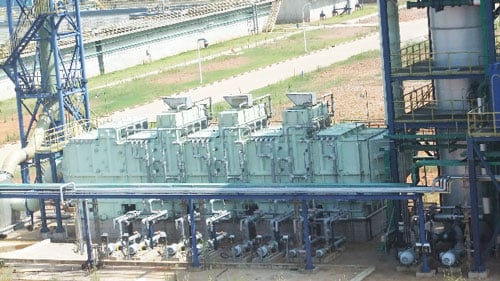
Contaminated gases first enter a horizontal charging section prior to entering a packed section containing Tellerette® Tower Packing. The particulate is charged and collected on ionizer plates and packing via electrostatic principles and “image force” attraction, where gases are absorbed and neutralized.
The IWS meets the most stringent MACT requirements for removal of particulate and heavy metals and has been tested to outlet loadings below 0.0008 gr/DSCF. It can be easily retrofitted to existing equipment to meet new regulatory requirements. IWS Pilot Test Program equipment is available for your evaluation.
Induced Surface Charge
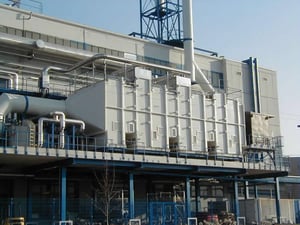 The predominant influence acting within IWS to collect submicron size particulate is the mechanism of image force attraction.
The predominant influence acting within IWS to collect submicron size particulate is the mechanism of image force attraction.
Image force attraction occurs whenever an electrostatically charged particle comes within the boundary layer (usually within one millimeter) of a neutral surface. As the charged particle comes close to the neutral surface, an electrostatic charge of opposite polarity is induced at the neutral surface.
The force of attraction is similar to that which would exist between a charged particle and an imaginary particle of equal but opposite polarity located at an equal distance behind the surface. It is as though the charged particle was seeing its "mirror image."

 The Verantis® Ionizing Wet Scrubbers, or IWS®, are developed to simultaneously remove noxious gases and particulates from industrial process airstreams while eliminating opacity. With more than 100 installations worldwide, IWS systems have been at work for five decades, solving the most demanding environmental control challenges.
The Verantis® Ionizing Wet Scrubbers, or IWS®, are developed to simultaneously remove noxious gases and particulates from industrial process airstreams while eliminating opacity. With more than 100 installations worldwide, IWS systems have been at work for five decades, solving the most demanding environmental control challenges.
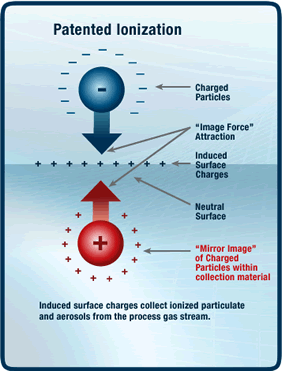 Combines established principles of electrostatic particle charging, image force attraction, inertial impaction, and gas absorption to collect submicron solid particles, liquid particles, and noxious and malodorous gases simultaneously
Combines established principles of electrostatic particle charging, image force attraction, inertial impaction, and gas absorption to collect submicron solid particles, liquid particles, and noxious and malodorous gases simultaneously The predominant influence acting within IWS to collect submicron size particulate is the mechanism of image force attraction.
The predominant influence acting within IWS to collect submicron size particulate is the mechanism of image force attraction.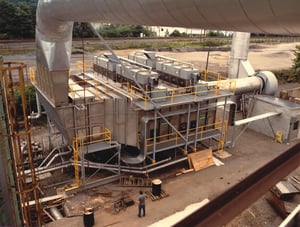 Metal Refining and Recovery - Metal oxides, metal salts and acid gases
Metal Refining and Recovery - Metal oxides, metal salts and acid gases